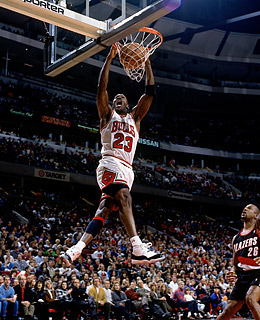
The ludicrously gifted Michael Jordan wasn’t content with one comeback — or even one sport. By the time of his first retirement from basketball in 1993, he had amassed enough individual and team accomplishments with the Chicago Bulls — like the 1991-93 NBA championships three-peat — to be rightly recognized as the greatest player who’d ever lived. But being the best was getting tiresome; Jordan soon signed a minor league baseball contract with the Chicago White Sox and was invited to spring training. He never made a major league start, progressing as far as the Class AA Birmingham Barons of the Southern League (where it should be noted he batted .202 for the 1994 season with 51 RBIs and 30 stolen bases.)
During the following year, he announced his return to the Chicago Bulls with possibly the most nonchalant press release in history: “I’m back.” And the very next day, wearing jersey number 45 (his famous 23 had been retired in his honor the first time he’d hung up his high-tops) Jordan scored 19 points against the Indiana Pacers — a game that scored the biggest TV audience for a regular-season NBA game since 1975. With Jordan back crashing the boards, the Bulls pulled off another three-peat between 1996-98; their gifted guard called it a day yet again in January 1999. Still, His Airness wasn’t remotely done. After becoming part owner and president of basketball operations for the perennially struggling Washington Wizards, a frustrated Jordan reactivated himself in 2001, offering to donate the playing part of his salary to victims of the 9/11 attacks. Jordan’s final game eventually came in 2003 in Philadelphia. When he returned to the bench for the last time, he received a three-minute standing ovation from his teammates, opponents and the crowd. He hasn’t dunked a basketball professionally since.
